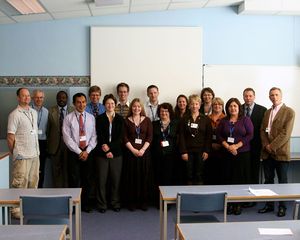Difference between revisions of "Veterinary Education Online"
| Line 121: | Line 121: | ||
! | ! | ||
| − | <h2 style="margin:0; background:#cedff2; font-size:120%; font-weight:bold; border:1px solid #a3b0bf; text-align:left; color:#000; padding:0.2em 0.4em;">Article of the Week - [[ | + | <h2 style="margin:0; background:#cedff2; font-size:120%; font-weight:bold; border:1px solid #a3b0bf; text-align:left; color:#000; padding:0.2em 0.4em;">Article of the Week - [[Rumination - Anatomy & Physiology|Rumination]]</h2> |
|- | |- | ||
|style="color:#000;"| | |style="color:#000;"| | ||
| − | [[Image: | + | [[Image:Diagram of ruminating contractions.jpg|thumb|right|150px|Diagram of ruminating contractions - Copyright RVC 2008]] |
| − | + | Rumination is the process of digestion in the ruminant. It involves three simplified processes. the first is regurgitation which increases the surface area of food particles for digestion through further mechanical breakdown. The second is re-[[Mastication|mastication]] and the third reinsalivation. Reinsalivation increases the volume of saliva produced whilst chewing and allows minerals to be recycled. | |
| − | |||
| − | === | + | ==Process== |
| − | |||
| − | + | *Reflex initiated by mechanical stimlation of the receptors in the mucosa of the [[The Reticulum - Anatomy & Physiology|reticulum]], ruminoreticular fold and cardiac area of the [[The Rumen - Anatomy & Physiology|rumen]] | |
| − | |||
| + | *Frequency of contractions depends on the animal's activity | ||
| + | *E.g. Cattle fed on hay or straw have the most frequent contractions at 79-100 per hour during feeding, 55-76 per hour during rumination | ||
| + | *E.g. Cattle that are resting (not feeding or ruminating) only have contractions 47-80 per hour | ||
| + | *Discrete reticular contraction preceedes biphasic ruminal contraction (see [[The Rumen - Anatomy & Physiology#Ruminoreticular contraction|ruminoreticular contractions]]) | ||
| − | [[ | + | *Rumination depends upon the coordination of the stomach movements with the thoracic wall and throat |
| + | |||
| + | *Associated with inspiration against a closed glottis creating a negative pressure in the thorax allowing ingesta to be drawn into the [[Oesophagus - Anatomy & Physiology|oesophagus]] | ||
| + | |||
| + | *Ingesta carried orally via an antiperistaltic wave | ||
| + | |||
| + | *Controlled by rumination centres in the hypothalamus | ||
| + | |||
| + | *Fibre increases stomach motility | ||
| + | |||
| + | *Increase in [[Volatile Fatty Acids - Anatomy & Physioogy|volatile fatty acids]] decrease stomach motility | ||
| + | |||
| + | [[Rumination - Anatomy & Physiology|Click here to read more]] | ||
|} | |} | ||
|- | |- | ||
Revision as of 13:24, 18 November 2008
|
Welcome to WikiVet,
A collaborative initiative between the UK Vetschools to develop a comprehensive on-line veterinary knowledge base.
5,936 articles.
| ||||||||||||||


